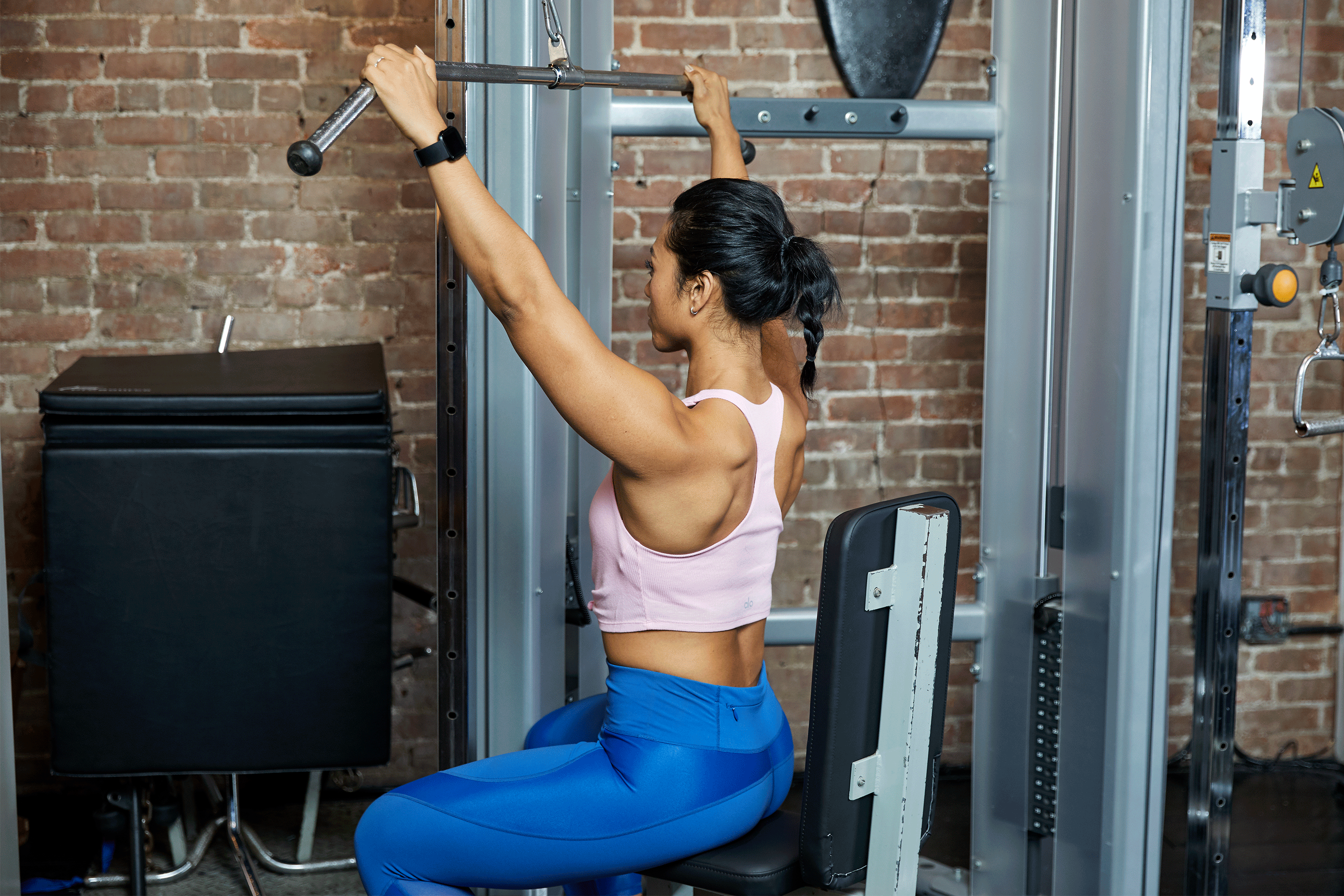Lat pulldowns shape and strengthen the upper back. According to study in the Journal of Strength and Conditioning Research, the Lat pulldown is one of the best exercises for targeting the large, triangular latissimus dorsi (or “lats”) on the sides of the upper back. Despite its efficacy, the Lat pulldown is often performed improperly due to a lack of understanding or form. This article explains the Lat pulldown so you can strengthen and define your upper back.
The Journal of Sports Science and Medicine found that the Lat pulldown activates the lats, traps, and rhomboids better than other upper-body exercises. The Lat pulldown also targets the lats better than pull-ups, giving it a great alternative for folks who can’t do them. Correctly done Lat pulldowns strengthen the upper back.
Right Way To Do a Lat Pulldown

The lat pulldown strengthens the back’s latissimus dorsi (lats) muscles. This cable machine exercise strengthens and defines the back. Follow the below expert instruction to do a Lat pulldown in the right way.
- First, secure the cable machine’s knee pad to your thighs. Sit at the machine with your back straight and chest out.
- Overhand hold the bar with hands somewhat wider than shoulder-distance apart. Keep your shoulders down and arms at your sides.
- Start by pulling the bar to your chest with your elbows close to your body. Lower the bar by contracting your back and shoulder blades.
- Slowly raise the bar from the action and pause. Don’t wobble or use momentum when lifting.
- Finish your set. During the workout, look straight ahead without craning.
- After your set, remove the bar and leave the equipment.
Start with a manageable weight and increase as strength grows. To maximize your workout, inhale as you lift the bar to your chest and exhale as you lower it.
The lat pulldown strengthens the lats, biceps, forearms, and upper back. It can strengthen your back as part of a total-body workout or alone. It strengthens your back, making you taller and toned.
Before starting a new exercise plan, consult your doctor or fitness professional. Before this workout, warm up with gentle cardio and stretching.
The Advantages of Lat Pulldown Exercises
It’s a fantastic form of physical activity that has many advantages including:
- Improved posture: Lat pulldowns strengthen the muscles that stabilise the spine and are therefore useful for improving one’s posture.
- Increased upper body strength: Lat pulldowns work the lats, biceps, forearms, and upper back. This workout can improve upper-body strength and back definition.
- Increased muscle mass: As you raise your strength and the amount of muscle mass in your back, you may see an increase in the total amount of muscle in your body.
- Reduced risk of injury: Having strong upper-body muscles, especially in the back, reduces the risk of shoulder or upper back injuries.
- Better athletic performance: Athletes who participate in upper-body sports like swimming, gymnastics, and rock climbing can benefit greatly from the lat pulldown.
- Improved flexibility: Upper-body flexibility increases mobility and reduces muscle stiffness as a bonus.
These benefits can be obtained by employing appropriate form and technique and starting with a weight you can handle and increasing as you get stronger. Before starting this activity, warm up with stretching and gentle cardio.
Which muscles are engaged during a Lat Pulldown?
The Lat pulldown targets the latissimus dorsi, or “lats,” a big back muscle. This muscle extends, adducts, and rotates the arm and creates the “V-shape” back.
Lat pulldowns work more than only the lats:
- Biceps: The front of the upper arm houses the biceps brachii, which help bring the bar down to the chest.
- Forearm muscles: Exercises that include gripping a bar need the use of the flexor and brachioradialis muscles of the forearm.
- Upper back muscles: The posterior deltoids, rhomboids, and trapezius are all activated in this motion, which aids in shoulder and upper back stability.
- Lower trapezius: One of the most crucial aspects of lat pulldown form is activating this muscle, which is responsible for bringing the shoulder blades together.
Use the ideal muscles and technique to maximize your workout. Strengthening and bulking your back increases your body’s total muscle mass. Warm up with light cardio and stretching before this workout.
What is the optimal frequency for performing Lat Pulldowns?
Depending on your fitness level and goals, you should determine how often you should perform lat pulldowns. Some rules of thumb are as follows:
- For muscle building: If you want to bulk up, do lat pulldowns 2-3 times a week with at least one day off. Doing so repairs and strengthens muscle tissue.
- For maintenance: To maintain muscular mass and strength, do lat pulldowns 1-2 times a week.
- For general fitness: Lat pulldowns can be done 1-2 times a week in a normal fitness plan.
These are broad guidelines, so modify the frequency to your recuperation time. Use appropriate form and technique, start with a weight you can handle, then gradually increase as you build strength. Before starting this activity, warm up with stretching and gentle cardio.
What is the optimal number of reps and sets for Lat Pulldown?
Your fitness goals and current fitness level will determine the ideal number of repetitions and sets for lat pulldowns. Some rules of thumb are as follows:
- For muscle building: If you want to gain back muscle, do 3-4 sets of 8-12 reps with a weight that challenges you but doesn’t break your form.
- For strength building: For upper body strength, do 3-5 sets of 5-8 reps with a heavy weight.
- For general fitness: For overall health, do 2-3 sets of 12-15 reps with a moderate weight for lat pulldowns.
What are Other Lat Pulldown Exercises
The latissimus dorsi is the primary muscle group that is worked during lat pulldowns. The following are a few more workouts that can target the latissimus dorsi muscle:
Pull-ups
This workout is quite similar to lat pulldowns, except instead of utilising a machine, you pull yourself up to a bar by using your own body weight. Pull-ups are considered to be a more difficult kind of exercise than using a machine since your own body weight creates a greater degree of resistance.
Chin-ups
This exercise is very similar to pull-ups, but instead of using an overhand hold, you will use an underhand grip. This will put more of an emphasis on your biceps.
Rows
Exercises that involve rowing, such as seated rows and bent-over rows, focus on strengthening the middle and upper back muscles, particularly the lats.
Cable Pullovers
This exercise is an isolation exercise that works not just on the lats but also on the shoulders, triceps, and serratus anterior muscles.
Pull-ups with different grip
You can try out different grips, such as broad, close, and neutral, which will target different muscle fibres and will bring additional variation to your workout.
Deadlifts
The lats, traps, and spinal erectors are some of the muscular groups that benefit from performing deadlifts, which are considered to be complex exercises.
Avoid These Mistakes When Performing Lat Pulldown
When practicing Lat Pulldowns, there are a few frequent faults that people make, which are as follows:
- Using too much weight: Overweight can cause poor form and damage. Start with a weight you can bear and increase as you get stronger.
- Not using a full range of motion: Lack of range of motion reduces workout effectiveness and causes muscular imbalances. Pull the bar to your chest and release it to the starting position.
- Leaning back: Leaning back while exercising might strain your lower back and distract from the lats. Stay straight and engaged throughout the exercise.
- Not keeping your shoulders back: Poor posture and exercise inefficiency result from not keeping your shoulders back. Exercise with your shoulders back and down.
- Not keeping your elbows close to your body: Keeping your elbows close to your body improves exercise and reduces injuries. Maintain elbow proximity throughout the exercise.
- Not Warm up properly: Not warming up might cause injury and impair exercise efficacy. Before starting this activity, warm up with stretching and gentle cardio.
Commonly Frequently Ask Questions
Can I perform lat pulldowns with an underhand grip?
Yes, you can utilise an underhand grip for lat pulldowns. This biceps-focused variation of the chin-up might be a useful addition to your programs.
For lat pulldowns, is a close grip acceptable?
You can perform lat pulldowns with a close grip. The teres major and inner lats are the primary targets of this variant.
Is it okay to use a resistance band for lat pulldowns?
People who don’t have access to a gym or a lat pulldown machine may find that performing the exercise using a resistance band is a viable option. Before beginning the workout, however, you should check to see that the band is correctly fastened and secure.
Can I use my bodyweight for lat pulldowns?
If you don’t have access to a gym or a lat pulldown machine, then performing the exercise with only your bodyweight is a viable option. The lat pulldown is a compound exercise that can be substituted with a chin-up or pull-up bar or a set of dumbbells.
How can I make lat pulldowns more challenging?
You can make lat pulldowns more difficult by increasing the weight, the number of repetitions or sets, or by switching to a closer grip or an underhand grip. One alternative is to move more slowly, placing more emphasis on the final, or “eccentric,” portion of the movement.












